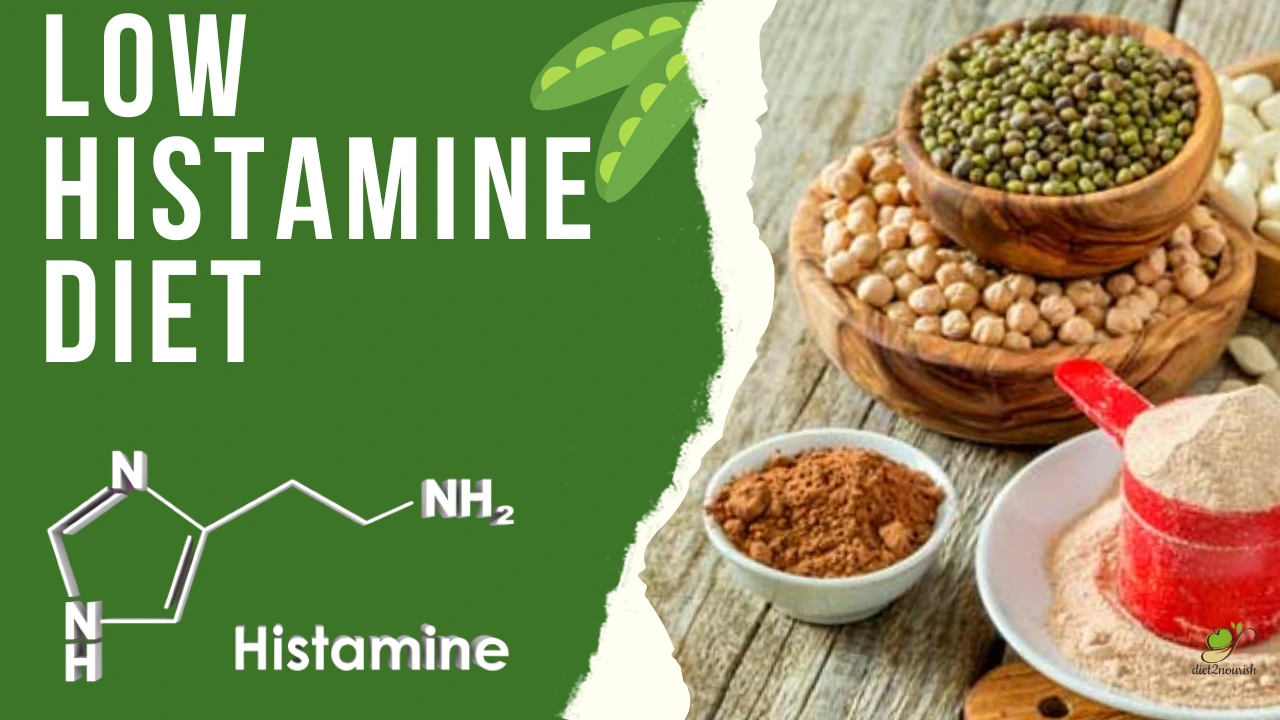Low Histamine Diet Chart
Hello there, dear readers! Today, we are diving into a fascinating world of health and nutrition called the “Low Histamine Diet.”
What is the Low Histamine Diet?
The Low Histamine Diet is a special way of eating that helps people who have histamine intolerance. Histamine is a natural chemical in our bodies and certain foods. For some folks, too much histamine can cause discomfort and bothersome symptoms.
By eating low-histamine foods, you can reduce those pesky symptoms like headaches, hives, and tummy troubles.
Finding Relief from Histamine Intolerance
At the heart of the Low Histamine Diet lies its remarkable ability to alleviate the symptoms of histamine intolerance. For those who experience recurring headaches, hives, digestive discomfort, or even anxiety after consuming certain foods, this diet is a beacon of hope. By eliminating high-histamine foods, the body can find respite from discomfort, granting individuals the relief they long for.
Identifying Trigger Foods
One of the most captivating benefits of the Low Histamine Diet is its role as a diagnostic tool. By following the diet and gradually reintroducing certain foods, individuals can pinpoint their specific trigger foods. This newfound knowledge empowers them to make informed dietary choices and tailor their eating habits to suit their unique needs.
Migraine Management
For those who battle with migraines triggered by histamine, the Low Histamine Diet can be a true lifesaver. The reduction of high-histamine foods may lead to a decrease in migraine frequency and intensity, enabling individuals to regain control over their lives and find solace from this debilitating condition.
Calming Chronic Urticaria
The Low Histamine Diet extends its healing touch to those troubled by chronic urticaria, persistent hives that refuse to fade away. By steering clear of histamine-rich foods, individuals may witness a reduction in the frequency and severity of hives, offering a welcome respite from this troublesome skin condition.
Nourishing the Gut
A lesser-known but powerful benefit of the Low Histamine Diet lies in its ability to support gut health. By opting for foods that are gentle on the digestive system and avoiding histamine triggers, this diet helps in nurturing the delicate balance of the gut microbiome. A healthy gut contributes to better overall health and improved histamine metabolism.
Boosting Energy and Vitality
As the body finds relief from histamine intolerance symptoms, a surge of renewed energy and vitality often follows suit. With discomfort lifted, individuals experience a newfound zest for life, enabling them to fully engage in their daily activities with a sense of vigor and enthusiasm.
Supporting Skin Health
As chronic urticaria becomes more manageable, the skin reaps the benefits of this dietary transformation. With a reduction in hives and inflammation, the skin can appear clearer, smoother, and more radiant, contributing to an enhanced sense of confidence and well-being.
What to Eat on the Low Histamine Diet
Here’s the exciting part – the foods you can enjoy on this special diet! Say hello to these delicious options:
Boiled meat:
Yummy, tender meat cooked in boiling water is your new best friend. It’s low in histamine and tastes great!
Boiled fish:
Fish cooked in a gentle, boiling bath is another fantastic choice. It’s safe and won’t cause those troublesome symptoms.
Eggs:
Whether boiled, fried, or poached, eggs are a perfect low-histamine option.
Legumes:
Chickpeas and lentils are fantastic low-histamine legumes that you can add to your plate.
The Benefits of the Low Histamine Diet
By following the Low Histamine Diet, you can experience some pretty fantastic benefits:
- Say goodbye to those bothersome headaches and hives.
- Manage that pesky condition called chronic urticaria (hives that stick around).
- If you get migraines, this diet might help ease them.
Things to Keep in Mind
Before you jump headfirst into the Low Histamine Diet, remember a few important things:
- This diet is a tool to figure out what foods trigger your symptoms. It’s not forever!
- While it helps you feel better, be careful not to miss out on essential nutrients. Make sure to eat a balanced diet.
What Causes Histamine Intolerance?
Histamine intolerance arises from an imbalance between the histamine levels in our bodies and our ability to break it down effectively. Histamine is a naturally occurring chemical messenger involved in various bodily functions, including digestion, immune response, and sleep regulation. Normally, enzymes in our bodies help break down histamine, ensuring it remains at optimal levels.
However, in some individuals, the enzyme responsible for histamine breakdown, called diamine oxidase (DAO), may be insufficient. This leads to an accumulation of histamine, causing an array of uncomfortable symptoms. The exact causes of this enzyme deficiency can vary and may be influenced by factors such as genetics, gut health, and certain medications.
How Do I Determine a Histamine Intolerance?
Detecting histamine intolerance can be tricky as its symptoms can overlap with other conditions. If you’ve experienced recurring headaches, hives, digestive issues, or even anxiety after consuming certain foods, histamine intolerance could be the culprit.
Consulting with a healthcare professional is essential in identifying histamine intolerance. Your doctor may conduct a thorough medical history review, perform physical exams, and may even recommend a histamine elimination diet.
The histamine elimination diet involves avoiding high-histamine foods for a period and then gradually reintroducing them. Monitoring your symptoms during this process can help pinpoint trigger foods and confirm histamine intolerance.
Which Foods Can Trigger Histamine Reactions?
Histamine reactions can be sparked by consuming foods that are high in histamine or that prompt the release of histamine in the body. Some common high-histamine foods include:
Fermented foods:
Sauerkraut, kimchi, pickles, and aged cheeses undergo fermentation, which increases their histamine content.
Smoked or processed meats:
Bacon, salami, and ham are examples of processed meats that can lead to histamine reactions.
Alcohol:
Wine, beer, and champagne have high histamine levels and may trigger symptoms in sensitive individuals.
Certain vegetables:
Spinach, tomatoes, eggplant, and avocados are rich in histamine and can cause reactions in some people.
Citrus fruits:
Oranges, lemons, and grapefruits can prompt histamine release in the body.
Canned and preserved foods:
Canned fish, canned vegetables, and certain sauces may have elevated histamine levels.
Remember, a histamine intolerance diagnosis should come from a qualified healthcare professional. By identifying trigger foods through an elimination diet and being mindful of histamine-rich choices, you can better manage your health.
Low histamine diets have garnered attention due to their potential to alleviate histamine intolerance symptoms. For individuals experiencing headaches, hives, digestive issues, or chronic urticaria (hives that persist), this dietary approach seems like a lifeline. By eliminating high-histamine foods, one can experience relief and better understand their body’s needs.
Pros of Low Histamine Diets
- Symptom Relief: One of the primary benefits of low histamine diets is the relief it provides from uncomfortable symptoms associated with histamine intolerance.
- Identification of Triggers: By carefully eliminating and reintroducing foods, individuals can identify specific trigger foods that worsen their symptoms.
- Migraine Management: For those who suffer from migraines triggered by histamine, this diet can offer some relief and aid in the management of this condition.
Cons of Low Histamine Diets
- Nutritional Imbalance: Low histamine diets can be quite restrictive, leading to potential nutritional imbalances. Essential nutrients may be limited, which could impact overall health and well-being.
- Unsustainable in the Long Run: The strictness of the diet may prove challenging to maintain over an extended period.
- Not a Cure-All: While low histamine diets can provide symptom relief, they do not address the root cause of histamine intolerance. It may only serve as a temporary fix rather than a complete solution.
Finding Balance: Low Histamine Diets as a Tool
Low histamine diets can be valuable tools in managing histamine intolerance.
- Diagnostic Tool: View the low histamine diet as a diagnostic tool to identify trigger foods and better understand your body’s unique needs.
- Short-Term Use: Consider using the diet for a short period to gain insights into your symptoms and trigger foods. Once you’ve identified the culprits, you can reintroduce a more diverse range of foods back into your diet.
- Nutritional Support: Work with a qualified healthcare professional to ensure that your nutritional needs are met while on the diet. Supplementing with vitamins or minerals may be necessary to prevent deficiencies.
A Holistic Approach to Wellness
Remember, a holistic approach to wellness goes beyond just dietary changes. Addressing lifestyle factors, stress management, and gut health play significant roles in managing histamine intolerance.
Stress Reduction:
Implement stress-reducing practices such as meditation, yoga, or spending time in nature. Reducing stress can positively impact histamine levels.
Gut Health:
Focus on improving gut health through probiotic-rich foods and a diverse range of prebiotic fibers. A healthy gut can support better histamine metabolism.
Balanced Diet:
Embrace a balanced diet that includes a variety of foods. Avoid over-restricting your choices to ensure you receive essential nutrients for optimal health.
Striking a Harmonious Balance
In the realm of low histamine diets, finding a harmonious balance is key. While this dietary approach can provide much-needed relief from histamine intolerance symptoms, it should be seen as a tool for understanding your body better.
Work with a healthcare professional to create a customized plan that addresses your individual needs. Combine dietary changes with stress reduction techniques, gut health support, and a balanced approach to nutrition.
With this holistic strategy, you can uncover the true potential of low histamine diets – not just as a band-aid fix, but as a stepping stone towards a harmonious and thriving state of wellness.
Let this knowledge empower you on your journey to health and vitality. Embrace a balanced diet, nourish your body with care, and embark on a path of wellness. The Low Histamine Diet might seem a bit overwhelming at first, but it’s just a way to help you feel your best. By avoiding high-histamine foods and enjoying the ones that are low in it, you can say goodbye to those troublesome symptoms.
Remember, it’s all about balance and listening to your body. Be kind to yourself and embrace this journey of wellness. With the Low Histamine Diet as your guide, you’ll discover a whole new world of nourishment and vitality.

